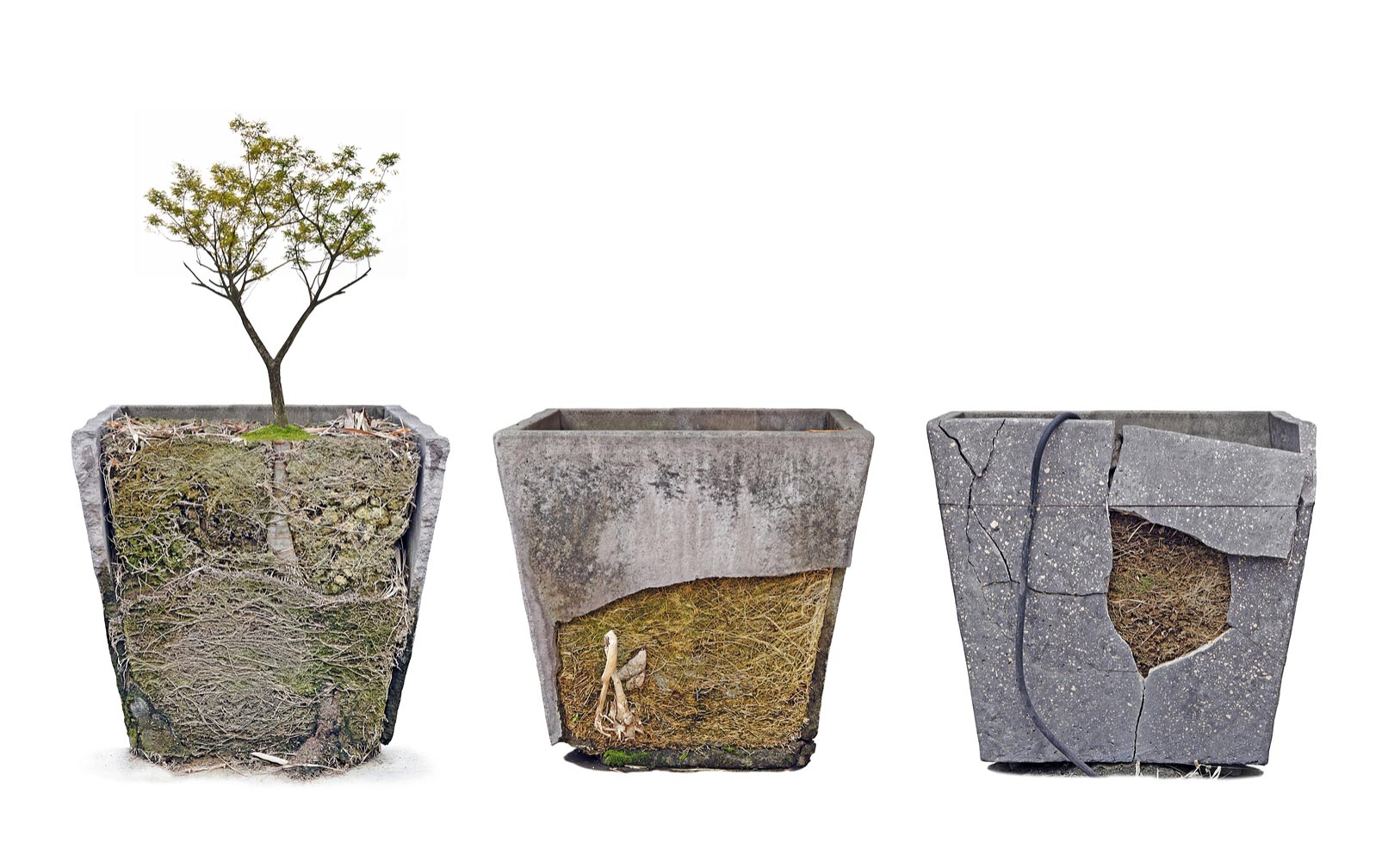Concrete is a sustainable building material but it’s not highly recommended for planters because of its weight, tendency to crack and porous makeup. Our resin-based planters can be made to imitate the industrial look of concrete planters without the same drawbacks. While a concrete home may last many years and weather extremely harsh storms, concrete planters fail to have the same durability.
Is Concrete A Sustainable Building Material?
While concrete is not ideal for planters, it is in fact a sustainable building material used in many eco-friendly homes. Unlike wood, it doesn’t require chopping down trees. Plus, concrete construction can last a very long time.
Concrete can be made from fly ash, slag cement, and silica fume, which are all waste byproducts derived from manufacturing facilities. The main raw material used in the formation of concrete is limestone, which happens to be the most abundant mineral on earth. Modern and eco-friendly homes often incorporate concrete floors and countertops in aims of skipping out on less sustainable materials such as wood. When used for most purposes, concrete is very durable and does not rust, burn or rot. By building a concrete home you can greatly increase the overall energy efficiency of your dwelling.
All of these benefits make it easy to assume concrete planters would be great too, but that’s not really the case. So why isn’t concrete a good material for planters?
The Drawbacks To Concrete Planters
Before we get into the drawbacks, concrete planters do have some benefits for which they deserve credit. They are incredibly heavy which makes them durable to a certain extent, and they are great at insulating plants against sudden temperature fluctuations. Concrete’s ability to absorb and radiate heat protects roots against late or early frosts. And now, the drawbacks…
Concrete is incredibly heavy. Add water, plants and soil into a large concrete pot and it’s going to be unimaginably heavy and difficult to move. If you need to move planters seasonally or just because you want to switch up your landscape design, you will likely need some sort of tools or machinery to do so. You’ll want to be careful and check up on weight limitations before placing concrete planters on certain platforms or balconies. Not to mention, the original shipping of concrete planters is more costly because of weight.
Concrete is not flexible, so while it’s heavy and sturdy it doesn’t stand up to impact damage all that well.
Concrete planters that do not go through the proper curing process will impact the alkalinity of plant soil. To complicate this matter, it’s difficult, if not impossible to know if a concrete planter went through the proper curing process.
Concrete is porous, which results in two different drawbacks. One, it may require the addition of sealant in order to keep water from evaporating too quickly out of the soil and drying out plant roots. Two, it’s more prone to absorbing salts and moisture from the air, resulting in the damage described below.
Concrete is prone to forming cracks, in fact the one thing concrete is certain to do at some point in time is crack. Cracks allow water to seep inside, and as the water heats up and cools down it freezes and thaws—compacting and expanding. This creates unsustainable pressure that ultimately results in more cracks and complete break down of the planter.
Many concrete planters do not have drainage holes, thus making root rot more likely. It is almost always impossible to add holes to concrete planters without damaging the planter.
How Our Resin-Based Planters Stack Up
Our resin-based composite blend planters are rotationally molded into strong and pliable products that can be made to look like a number of highly coveted materials. Our Linear Low Density Polyethylene, LLDPE, is a true Resin blend that originates in powder form. The powder is superheated and liquefied while in the mold and slow cooked on rotation. Pair the power of superior materials with our special Rotational Molding process and the result is long lasting flexible planters able to withstand breaking, cracking and shattering.
Benefits of our specially formulated resin-based planters include:
Blended with UV-12 inhibitors to provide a lifetime of vibrant color.
Stone, metal and concrete planters require endless maintenance, but our planters are maintenance free. After all, they don’t break or stain. Even if our planters are tagged with graffiti, it’s very easy to remove stains using over the counter cleaning products. Worst-case scenario, stains can be removed using a pressure cleaner.
Resin is non-porous and non-hydroscopic, which means water cannot penetrate surfaces, thus helping to prevent leaks, rust and discoloration.
Resin can be made to imitate the look of almost any material, plus it can be made in one of our 33 colors, or it can be custom colored any way you want. Want to add your company logo or emblem? No problem! Our resin-based planters are completely customizable. We also offer a few proprietary textured blends that look and feel like granite but are 90% lighter and a fraction of the cost.
Resin is much lighter than concrete, making it easier to move and cheaper to transport. Just because it’s lighter doesn’t mean it’s any less durable. In fact, we have literally thrown our planters off the roof of buildings to test durability, and they survive! Try doing that same thing with a concrete planter and it’s sure to crack into 10 million pieces.
All of our planters come with the option to add a self-watering basin that easily attaches to the bottom.
Our planters are made in America using eco-friendly production processes and carefully sourced materials. Our black products can be made from nearly 100% post-consumer recycled materials, and all of our products can be made from recycled materials. At the end of their long life, they are recyclable.
Learn more about our unparalleled resin-based planters: https://www.terracastproducts.com/what-is-resin/

